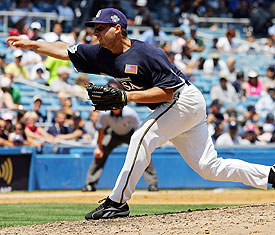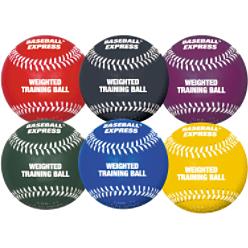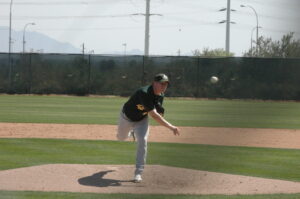Weighted Baseballs: Safe and Effective, or Stupid and Dangerous?
I get asked relatively frequently whether we use weighted baseballs with our pitchers, and if so, how they are incorporated. I figured it’d be worth a post to outline my thoughts. To answer these questions:
Do you use weighted baseballs?
Yes, with some of our pitchers. The asterisk that follows this statement is that they’re only implemented with those who have built a decent foundation of strength and mastered the fundamental mechanics of throwing a regular (5oz) baseball. So, the athletes we have that may be utilizing weighted baseballs are some of our pro guys, college guys, and more advanced high school guys. It is NOT something I think coaches should just implement on a gross scale with unprepared 13-year-old kids.
But aren’t weighted baseballs dangerous?
The first response that comes to mind is “Who decided a baseball should be 50z?” It’s actually a very arbitrary number.
Quarterbacks throw 14-16oz footballs (140z is the dry weight; balls actually become heavier as they’re used more). And, you could say that a lot of quarterbacks throw every day – and potentially even more than pitchers throw. Yet, they have far fewer elbow and shoulder problems than pitchers – and usually far less coaching on the mechanics of throwing than pitchers.
Granted, there are differences in the way that footballs are thrown, as compared to baseballs, but you have to consider that tripling the weight of the ball would increase arm stress, right? Wrong!
If you increase the weight of the implement, you slow down the arm action. In other words, you move further to the right on the absolute speed>>>>absolute strength continuum. In other words, weighted baseballs comprise a medium between traditional throwing drills (bullpens, long toss, flat ground drills) and what one encounters with medicine ball work and resistance training. If you slow down the arm action a bit, the deceleration demands drop – and it appears to be more arm-friendly.
How are weighted baseballs incorporated?
First, let me make two things abundantly clear:
1. You should never throw a weighted baseball off a mound (arm stress is higher when elevated) or with long-toss. We do all our weighted ball drills into a tarp/net from about 6-8 feet away.
2. You don’t play catch with weighted baseballs. Someone will get hurt if you try. Throw the ball, then walk to pick it up.
We don’t start throwing weighted baseballs until we’ve built guys up on their long tossing and the arm is 100% ready. In other words, weighted ball work starts up right around the time that bullpens start. As an example, most of our guys start throwing right after Thanksgiving, and pick up bullpens around January 10 after about 5-6 weeks of long-tossing and flat-ground drill work with the 5oz ball. The entire throwing program for them encompasses about 14 weeks (sometimes a bit longer or shorter, depending on the individual).
As an example, as I wrote previously, we used weighted balls with Oakland A’s minor league prospect Shawn Haviland last off-season, and he made a nice velocity jump from 87-88 to 90-94 in a single off-season. Looking back at Shawn’s program, his first session with weighted baseballs was January 11, and his last one was February 18th – so it wasn’t something he was doing year-round or in-season.
We have, however, had scenarios where guys have used weighted baseballs to get ready for fall throwing appearances (for example, the World Wood Bat Tournament in Jupiter, FL every October). These guys push their winter throwing programs back because they accumulated mileage on their arms in the fall (one reason I don’t love fall baseball, but it’s part of the game as it’s played nowadays).
When the time comes to implement the weighted baseball drills, they are either done as after long toss, after a bullpen, or as a stand-alone training session. They are never done before a bullpen, which comprises complete specificity with which you don’t want to interfere.
All of our weighted baseball drills generally take place in the 7-11oz range. I do, however, know some very bright minds in the field who will go heavier.
We always bring the athlete back to the normal 5oz ball at the end of each set. So, it might be three throws at 7oz, three throws at 9oz, and then three throws at 5oz, then rest. Other coaches may build all the way up (five at 7oz, five at 9oz, and five at 11oz) and then work their way back down to 5oz at the end of the session. Personally, I prefer to keep the learning loop short and keep the athlete cognizant of the 5oz feel with repeated sets as opposed to one big one.
Matching the drill to the weight of the ball is absolutely imperative, too. As a general rule of thumb, I do not go above 8oz for any drill that has a considerable lay-back (as pictured below) component, as the stress on the elbow is already pretty high in this position.
We can go considerably heavier with drills that are more focused on what’s happening out in front of the body, though.

Which weighted baseballs do you use?
We use this set from BaseballExpress.com; it includes 7-12oz balls, which is sufficient for most individuals.
Sign-up Today for our FREE Baseball Newsletter and Receive a Copy of the Exact Stretches used by Cressey Performance Pitchers after they Throw!






